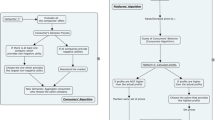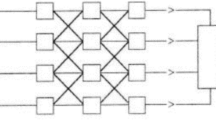Abstract
Distributed Artificial Intelligence (DAI) concepts and ideas are used to model dynamic strategic interaction among producers in oligopolistic markets. Results of a laboratory experiment with human agents in the role of duopolists were used to design an architecture of artificial agents. A system in which these artificially intelligent agents interact as duopolists in a market environment was implemented and tested. The artificial agents exhibit some of the learning and adaptive capabilities observed in human subjects and the system is able to reproduce the overall pattern of interaction of the laboratory experiments. Results so far encourage us to think that the implementation of a computational test-bench for research in economic strategic interaction based in DAI techniques is possible and may contribute to theoretic progress in economics.
Preview
Unable to display preview. Download preview PDF.
Similar content being viewed by others
References
ARTHUR, W.B.“Learning and Adaptive Economic Behavior — Designing Economic Agents that Act Like Human Agents: a Behavioral Approach to Bounded Rationality”. The American Economic Review. Vol.81, n.2. 1991.
CHAMBERLIN, E.. “ The Theory of Monopolistic Competition”. Cambridge, Mass.: Harvard University Press. 1933.
COELHO, H.; GASPAR, G.; RAMOS, I. “Experiments in Modelling Communication among Autonomous Agents”. Proceedings of I.F.I.P. WG 8.3 Working Conference on Decision Support Systems.Fontainebleu (France), 1–3 July 1992.
CYERT, R.M.; MARCH J.G. “Processus de décision dans l'entreprise”. Dunod. Paris. 1970.
FRIEDMAN, M. “Essays in Positive Economics”. University of Chicago Press. 1953.
GASPAR, G. “Communication and Belief Changes in a Society of Agents”. Proceedings of the Fifth Rocky Mountain Conference on Pragmatics in A.I.,Las Cruces (U.S.A.), June 28–30, 1990.
GASPAR, G.; COELHO, H. “A Modular Architecture for Agents Living in Society”. INESC Research Report. 1991.
HOLLAND, J.H.; MILLER, J. H. “Artificial Adaptive Agents In Economic Theory”. The American Economic Review. Vol.81, n. 2. May 1991.
MARIMON, R.; McGRATTAN E.; SARGENT, T.J.. “Money as a Medium of Exchange in an Economy With Artificially Intelligent Agents.”. Journal of Economic Dynamics and Control. n. 14. pp. 329–373. 1990.
MILLER, R. M.. “Markets as Logic Programs”. Artificial Intelligence in Economics and Management. L. F. PAU (Editor). Elsevier Science Publishers B. V. (North-Holland). 1986a.
MILLER, R. M. “On distributing the Intelligence of Economic Processes”. L'Èconomique et L'Intelligence Artificielle. Conference Internationale IFAC. Aug. 31–Sep. 4 1986b.
MONTEIRO, J. C. “Model of a Society of Intelligent Systems” (in Portuguese). LNEC Report. 1989.
PLOTT, C. R.. “Industrial Organization Theory and Experimental Science”. Journal of Economic Literature. Vol. 20. pp 1485–1527. 1982.
SERNADAS, C.; COELHO, H.; GASPAR, G.. “Communicating Knowledge Systems: Big Talk among Small Systems”, Applied Artificial Intelligence, Vol. 1, nos. 3–4, pp. 233–260 and 315–335. 1987.
SMITH, V. L.; WILLIAMS, A. W.; BRATTON, W. K.; VANNONI, M. G.. “Competitive Market Institutions: Double Auctions vs. Sealed Bid-Offer Auctions”. The American Economic Review. Vol. 72. pp 58–77. 1982a.
SMITH, V. L.. “Microeconomic Systems as an Experimental Science”. The American Economic Review. Vol. 72. pp 923–955. 1982b.
STAR, S. “Trader: A Knowledge-Based System for Trading in Markets”. L'Èconomique et L'Intelligence Artificielle. Conference Internationale IFAC. Aug. 31–Sep. 4 1986.
TVERSKY, A.; KAHNEMAN D. “Rational Choice and the Framing of Decisions” in HOGARTH, R.M., REDER, M. (ed.).“Rational Choice — The Contrast Between Economics and Psychology”. The University of Chicago Press. 1986.
Author information
Authors and Affiliations
Editor information
Rights and permissions
Copyright information
© 1994 Springer-Verlag Berlin Heidelberg
About this paper
Cite this paper
Caldas, J.C., Coelho, H. (1994). Strategic interaction in oligopolistic markets — experimenting with real and artificial agents. In: Castelfranchi, C., Werner, E. (eds) Artificial Social Systems. MAAMAW 1992. Lecture Notes in Computer Science, vol 830. Springer, Berlin, Heidelberg. https://doi.org/10.1007/3-540-58266-5_9
Download citation
DOI: https://doi.org/10.1007/3-540-58266-5_9
Published:
Publisher Name: Springer, Berlin, Heidelberg
Print ISBN: 978-3-540-58266-3
Online ISBN: 978-3-540-48589-6
eBook Packages: Springer Book Archive





